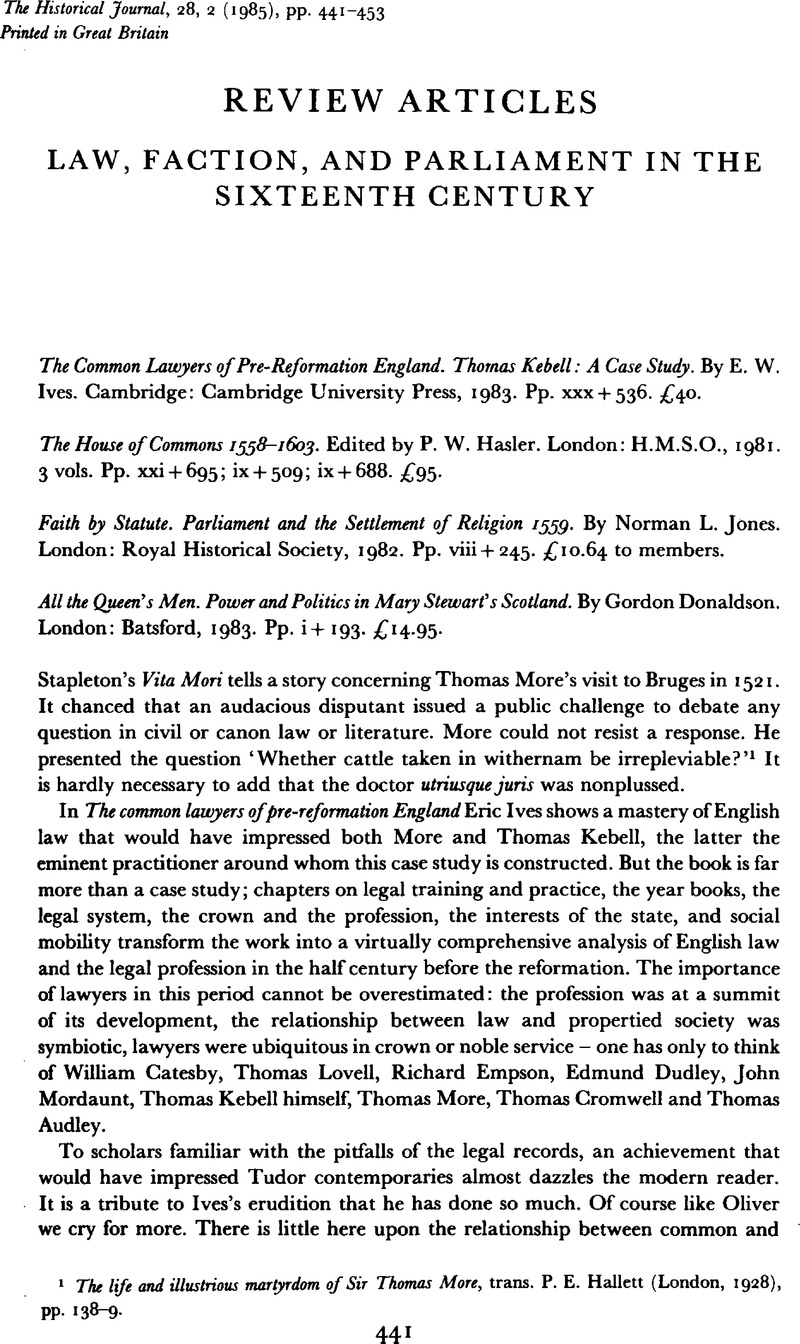Published online by Cambridge University Press: 11 February 2009

1 The life and illustrious martyrdom of Sir Thomas More, trans. Hallett, P. E. (London, 1928), pp. 138–9Google Scholar.
2 Cf. Guth, D. J., ‘Enforcing late-medieval law: patterns in litigation during Henry VII's reign’, in Legal records and the historian, ed. Baker, J. H. (London, 1978), pp. 80–96Google Scholar.
3 The best edition was corrected by T. E. Tomlins (2 vols., London, 1797).
4 See also The reports of Sir John Spelman, ed. Baker, J. H. (2 vols., London: Selden Society, 1977–1978), II, 123–37Google Scholar.
5 Elton, G. R., Studies in Tudor and Stuart politics and government (3 vols., Cambridge, 1974–1983), II, 92–109Google Scholar.
6 Guy, J. A., Christopher St German on chancery and statute (London: Selden SocietyGoogle Scholar, forthcoming).
7 Haigh, C., ‘Anticlericalism and the English reformation’, History, LXVIII (1983), 391–407CrossRefGoogle Scholar. This paper is unusually myopic but its spirit of inquiry is challenging.
8 See also Blatcher, M., The court of king's bench 1450–1550 (London, 1978), pp. 10–33Google Scholar; Guy, , The public career of Sir Thomas More (Brighton, 1980), pp. 37–49Google Scholar.
9 Although cases involving uses came into star chamber virtually none turned in argument on the equity of uses. Cf. Guy, , ‘The development of equitable jurisdictions, 1450–1550’, in Law, litigants and the legal profession, ed. Ives, E. W. and Manchester, A. H. (London, 1983), pp. 80–6Google Scholar.
10 Guy, , Sir Thomas More, pp. 40–93Google Scholar.
11 The index excludes parliamentary constituencies and M.P.s!
12 Hexter, J. H., ‘The birth of modern freedom’, Times Literary Supplement (21 06 1983), pp. 51–4Google Scholar.
13 Twelve civil lawyers are excluded from my calculations.
14 ‘Modern freedom’, p. 53.
15 Notestein, W., ‘The winning of the initiative by the house of commons’, Proceedings of the British Academy, XI (1924–1925), 71Google Scholar.
16 Neale, J. E., The Elizabethan house of commons (London, 1963 edn), p. 295Google Scholar. I am grateful to Mrs Rachel Guy for help and advice in compiling the tables and figures that follow.
17 William Lambarde's notes on the procedures and privileges of the house of commons, ed. Ward, P. L. (London: House of Commons Library document no. 10, 1977), pp. 34–5Google Scholar. Cf. Prest, W. R., The inns of court under Elizabeth I and the early Stuarts (London, 1972), pp. 222–3, 246–7Google Scholar.
18 The house of commons 1558–1603, II, 133.
19 Ibid. II, 139.
20 Ibid. II, 186.
21 Ibid. II, 260.
22 Ibid. III, 362.
23 Especially Elizabethan house of commons, and Elizabeth I and her parliaments (2 vols., London, 1969 edn)Google Scholar.
24 See also Neale, , ‘The Elizabethan acts of supremacy and uniformity’, English Historical Review, LXV (1950), 304–32CrossRefGoogle Scholar.
25 Cf. Heal, F., Of prelates and princes (Cambridge, 1980), p. 204CrossRefGoogle Scholar.
26 Ives, , Common lawyers, pp. 257–9Google Scholar.
27 Alexander, G., ‘Bishop Bonner and the parliament of 1559’, Bulletin of the Institute of Historical Research, LVI (1983), 164–79CrossRefGoogle Scholar.
28 Elton, , Studies, 183–215Google Scholar; Ives, , ‘Faction at the court of Henry VIII: the fall of Anne Boleyn’, History, LVII (1972), 169–88CrossRefGoogle Scholar; Starkey, , ‘The king's privy chamber, 1485–1547’ (unpubl. Ph.D. dissertation, Cambridge, 1973)Google Scholar; Hoak, , The king's council in the reign of Edward VI (Cambridge, 1976)Google Scholar.